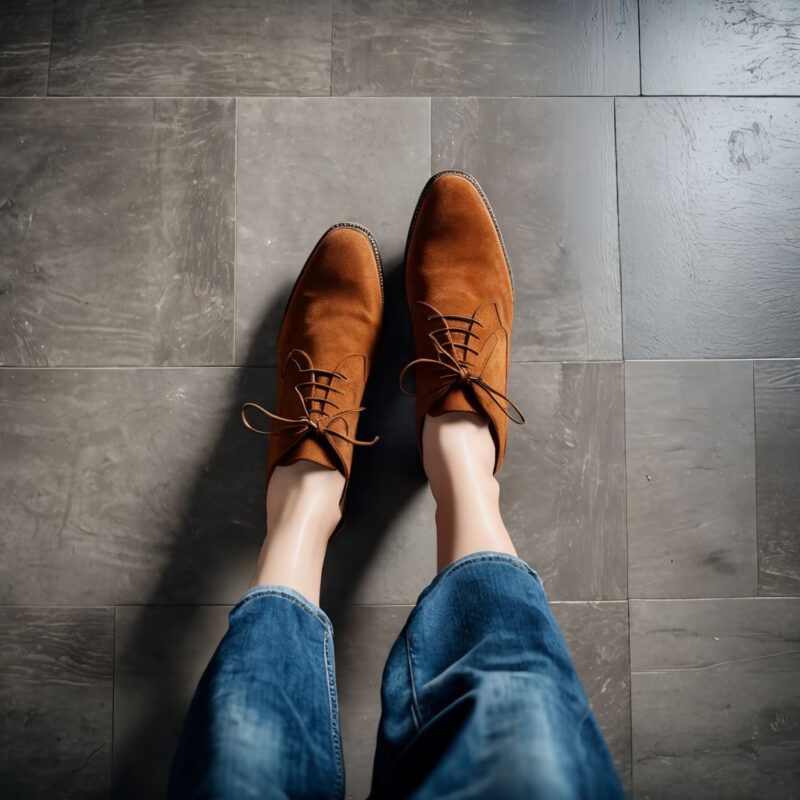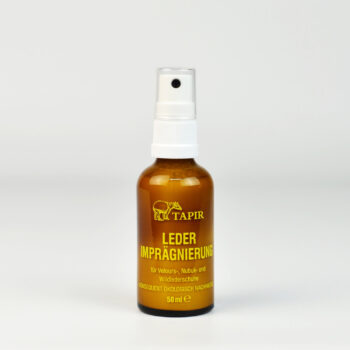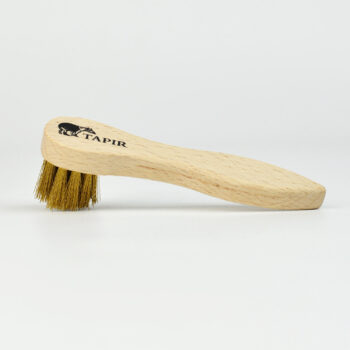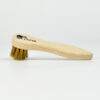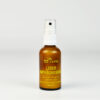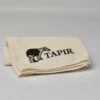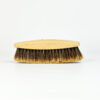Questions and answers
Understanding suede – Questions and Answers
More questions and answers about suede.
Suede is usually made from animal skins from cattle, sheep or goats. The manufacturing process consists of several steps:
1. Tanning: First, the animal skins are cleaned and tanned to make them durable. This can be done with vegetable or chemical tanning agents.
2. Cutting: After tanning, the hides are cut into the desired shape and size. The so-called grain leather, which refers to the upper layer of the skin, is removed in the process. This preserves the soft and velvety surface of the suede.
3. Sanding: The inside of the skin is then sanded. This further enhances the characteristically soft and fluffy texture of the suede. Depending on the desired finish, this sanding process can vary.
4. Dyeing: After sanding, the suede is still dyed. This is done by, such as dipping it in paint baths or spraying paint onto the surface.
5. Finish: Finally, the suede is treated with a protective agent, which makes it more resistant to stains and wear.
6. Drying and storage: After treatment, the suede is then dried and stored for sale or further processing.
In summary, the entire process requires a great deal of care and expertise to ensure the quality and characteristic properties of the suede.
Suede is a particularly valued material because it has quite special properties. The first is its soft and velvety surface, which gives a pleasant feeling to the touch and is often perceived as luxurious. This softness makes suede not only comfortable, but also adds a very elegant touch to any garment or accessory.
Another advantage of suede is its breathability. The material allows air to circulate and is therefore particularly comfortable to wear, especially in warmer areas. Due to this property, wearing suede is not uncomfortable even during prolonged use.
However, suede is also more sensitive than other types of leather. For example, it can easily get stains and scratches. For this reason, careful care and regular cleaning with the right products is important to maintain its beauty and functionality. In addition, it is essential to protect suede from moisture. This is because the absorbed water in the suede can lead to permanent damage and unsightly stains.
Overall, however, suede is a great material that scores with its softness and breathability, but also requires special care to preserve its properties in the long term.
For the latter, we at Tapir are here for you. Because we have the optimal products that are precisely tailored to the care of suede and thus make the care process easier for you.
There are several reasons why suede is appreciated. First of all, it has a unique, velvety surface that both looks very appealing and gives an elegant look. This characteristic look ensures that it is popular in many fashion and interior design areas.
Secondly, the feel of suede plays a major role. It feels soft and supple, making it a comfortable material for clothing, shoes and furniture. The pleasant touch also contributes to a luxurious feeling.
Last but not least, suede also offers a high level of comfort. It adapts well to the shape of the body and ensures a comfortable fit. It is also breathable, which makes it ideal for various applications.
All these properties make suede a valued material in the fashion and interior design world.
Although suede is a popular material prized for its soft texture and elegant look, it also comes with some challenges in terms of care and durability. Here are some of the most common challenges.
First of all, there is the sensitivity to stains . Since suede absorbs moisture, it is quite susceptible to stains. For this reason, it is important to always treat spills directly to avoid permanent stains.
Next, cleaning suede can be more difficult than smooth leather. Normal cleaning agents can damage the material. Therefore, it makes sense to use special suede cleaning products. For example, our suede eraser, the suede brush or the impregnation spray for suede, suede and nubuck leather are suitable for this.
The third is the risk of wear and tear . Because with frequent use without regular care, suede can wear out and lose its structure. To counteract this, the material should be treated regularly with a special suede brush to put the fibers back up and also extend the life of the suede.
Water sensitivity is a next challenge with suede. It is not waterproof and can be damaged by moisture. Therefore, it is advisable to always protect it from rain and, above all, to protect it regularly with a suitable water-repellent impregnation.
Finally, color changes should be mentioned among the challenges. In direct sunlight, suede can fade. For this reason, it makes sense to always keep it in a shady place to preserve its color intensity.
In the end, there are a few things to keep in mind. But with this knowledge and the right care products, suede can also last a long time and not lose its appearance.
Below are some tips for storing suede products to maintain their quality and longevity.
Dry and cool storage is important to avoid moisture and mold growth.
In addition, good air circulation should be ensured. Narrow plastic containers and plastic bags, for example, are absolutely unsuitable for storage as they restrict breathability.
To avoid color fading, do not store your suede in direct sunlight.
Furthermore, be careful not to use your suede
to be stored crushed or stacked to avoid deformation.
Last but not least, regular maintenance is enormously important. So clean and brush the suede regularly and especially before prolonged storage, with special materials, such as our suede eraser or the suede brush with brass bristles, to remove dust and dirt and refresh the fibers.
Suede is a versatile material that can be optimally integrated into different outfits and styles. Here are some tips on how to combine suede in style.
Choose neutralor classic colors such as black, brown, beige or gray for suede pieces. These colors are easy to combine with other garments and look elegant.
To create interesting textures, suede can also be combined with other materials . For example, it goes well with cotton, denim or wool. A suede skirt, for example, can be perfectly combined with a coarsely knitted sweater.
Use the layering principle or the onion look to add depth to your outfit. A suede jacket over a simple T-shirt or blouse can elevate a casual look.
Suede accessories such as bags, shoes or belts can add the finishing touch to an outfit. But make sure that the colors and styles of the accessories match the rest of the look. You should also make sure that the suede always looks well cared for . The easiest way to do this is to regularly refresh it with special suede items such as our suede eraser or the suede brush with brass bristles. Also make sure that shoes in particular are always properly impregnated so that you are not so susceptible to moisture. Our impregnation for suede, nubuck and suede is suitable for this purpose.
For formal occasions, you can also wear suede in combination with elegant dresses or suits. A suede blazer over a simple dress, for example, can create a chic look.
Suede is also great for casual outfits. A suede jacket combined with jeans and sneakers leads to a relaxed but stylish look.
Last but not least , color accents should be mentioned. If you choose a suede piece in a bold color, such as red or blue, it can be used as an eye-catcher in your outfit. The rest of the look should then be kept neutral to highlight the suede piece.

 Deutsch
Deutsch
